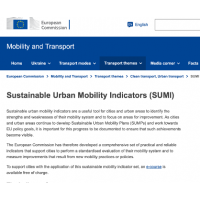Description
The ability of cities to employ and beneficially integrate them into the ecosystem relies on their innovation readiness level, as described in the previous chapter, and on the level of a city’s liveability.
The liveability component assesses factors that will ease the implementation of innovative mobility solutions. It covers mobility strategies, planning practices, environmental impacts of the mobility system, the affordability, availability and accessibility of mobility services, safety and security issues, the convenience of using mobility services, and user acceptance.
The following table contains some indicative KPIs for the liveability sub-elements:
| City Elements | Sub-element | Indicative PIs | ||
|---|---|---|---|---|
| Innovative Governance & Growth | L1 | Planning Investments |
> Levels of planning process transparency, > No Master Plans and urban legislation |
|
| Climate and City Typology | L2 | Sustainability |
> CO₂ equivalent or GHG emissions from transport (% of GHG emissions from urban transport) > European Air Quality Index > Noise levels |
|
| Smart & Easily accessible | L3 | Accessibility |
> Access to mobility services (the ease with which all categories of passengers can use public transport) > Accessibility for vulnerable groups to mobility services (the ease with which vulnerable passengers can use public transport) > Share of inhabitants with mobile internet access (sharing services) > SDG - % population within 500 meters of a PT station > No. of Roads, highways, public transport stations |
|
| L4 | Affordability |
> Urban deliveries prices (€/package) > Public transport prices > Parking prices > Monthly ticket cost per average income > Cost of a one km taxi ride as a percentage of average income |
||
| L5 | Availability |
> Share of public transport (%) > Share of car transport (%) > Share of micro-mobility (%) > Share of active transport (%) > Share of car-sharing transport |
||
| Safe & Secure | L6 | Safety and security |
> Bikes/E-scooter accidents per 100000 inhabitants > Public transport accidents per 100000 inhabitants > Car transport accidents per 100.000 inhabitants > Share of urban mobility accidents involving on-demand bike/scooter deliveries > Fatalities including micro-mobility means |
|
| Smart & Innovative Resources and Infra available | L7 | Efficiency |
> Share of urban space for public transport > Share of urban space for private/shared cars > Share of urban space for cycling/scooter lanes > Share of urban space for pedestrian areas > Number of autonomous/automated PT services on dedicated lanes |
|
| L8 | Convenience |
> Total passenger trips per day. > The average journey to work in minutes. > The average number of vehicles entering the city daily > Congestion > User trips expected per day |
||
| Innovative People & Stakeholders | L9 | Behaviour and smartness |
> The behaviour of users? E.g., implement access restrictions / regulate parking (No parking violations). > Users’ perception of micro-mobility devices. > Users’ perception of biking as dangerous. > User perception of car use as expensive. > Size of the population above minimum user age. |
|
For facilitating the self-assessment of the liveability of a city, SPROUT partners developed the Liveability Assessment Tool. By using this self-assessment tool, the cities can better understand their ability to implement of mobility innovations. While the Innovation Readiness Assessment focuses on the general capacity of cities to take up innovations, the scope of the Liveablity Assessment is more on the mobility system (infrastructure, availability of public transport, mobility strategies, transport-related emissions, or transport safety)
The tool includes a total of 22 questions for the 9 sub-elements described before and the city could answer in a 0-5 scale range, with a detailed description of each scale provided with concrete numerical ranges. The way a city is react to new innovative mobility solutions and adopts them into the everyday life of the citizens is the expected result of this tool.
SPROUT material and tools
Other relevant tools and methods
Data required
The liveability assessment is a qualitative questionnaire with pre-defined answer options. Answering the liveability assessment requires expert and practitioners’ knowledge.
Further information
This section builds on SROUT Deliverable D5.2 Urban policy system dynamics model, authored by E. Xenou, D. T. Touloumidis, and G. Ayfantopoulou (CERTH).



